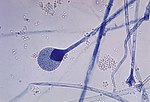The lycophytes, when broadly circumscribed, are a group of vascular plants that include the clubmosses. They are sometimes placed in a division Lycopodiophyta...
16 KB (1,449 words) - 23:13, 2 April 2024
Lycopodiopsida (category Lycophytes)
Lycopodiopsida is a class of vascular plants also known as lycopods or lycophytes. Members of the class are also called clubmosses, firmosses, spikemosses...
26 KB (2,509 words) - 20:27, 3 June 2024
reproduction is hidden. Ferns, horsetails (often treated as ferns), and lycophytes (clubmosses, spikemosses, and quillworts) are all pteridophytes. However...
17 KB (1,655 words) - 18:04, 19 June 2024
Selaginella martensii (category Lycophyte stubs)
Selaginella martensii, the variegated spikemoss or Martens's spike moss, is a lycophyte in the Selaginellaceae family. It is native to Mexico and Central America...
1 KB (103 words) - 13:47, 9 January 2024
Lepidodendron (category Prehistoric lycophytes)
stages of growth. However, they are correctly defined as arborescent lycophytes. They thrived during the Carboniferous Period (358.9 to 298.9 million...
19 KB (2,039 words) - 18:54, 3 October 2024
tip of a shoot axis. The earliest trees were tree ferns, horsetails and lycophytes, which grew in forests in the Carboniferous period. The first tree may...
124 KB (12,853 words) - 11:49, 17 November 2024
algae and the embryophytes or land plants (hornworts, liverworts, mosses, lycophytes, ferns, conifers and other gymnosperms, and flowering plants). A definition...
95 KB (8,067 words) - 16:08, 5 November 2024
from Christenhusz et al. (2011a), Pteridophyta from Smith et al. and lycophytes and ferns by Christenhusz et al. (2011b) The cladogram distinguishes the...
23 KB (2,031 words) - 23:13, 8 November 2024
Lycophytes †Barinophytopsida †Zosterophyllopsida Lycopodiopsida (clubmosses, spikemosses & quillworts)...
138 KB (14,773 words) - 09:08, 30 October 2024
Additional structural support was provided in lycophytes by a special periderm tissue in the outer cortex. Lycophyte trees exhibit determinate growth. These...
2 KB (226 words) - 06:32, 14 August 2024
(pdf here) PPG I (2016). "A community-derived classification for extant lycophytes and ferns". Journal of Systematics and Evolution. 54 (6): 563–603. doi:10...
2 KB (170 words) - 21:29, 22 November 2023
Iridescences based on multiple layers of cells are also found in the lycophyte Selaginella and several species of ferns. Iridescent Begonia leaf Selaginella...
20 KB (1,973 words) - 09:05, 2 November 2024
group of "seed ferns"), and the Voltziales, appeared. The Carboniferous lycophytes of the order Lepidodendrales, which are cousins (but not ancestors) of...
115 KB (12,087 words) - 20:00, 19 November 2024
Embryophyte (section Lycophytes and euphyllophytes)
polysporangiophytes. Living embryophytes include hornworts, liverworts, mosses, lycophytes, ferns, gymnosperms and angiosperms (flowering plants). Embryophytes have...
41 KB (3,854 words) - 01:24, 14 November 2024
Lycophytes †Barinophytopsida †Zosterophyllopsida Lycopodiopsida (clubmosses, spikemosses & quillworts)...
37 KB (2,808 words) - 01:20, 20 November 2024
Pseudophegopteris. As of January 2020[update], both the Checklist of Ferns and Lycophytes of the World and Plants of the World Online regarded Pseudophegopteris...
5 KB (392 words) - 20:33, 14 October 2023
Sigillaria (category Prehistoric lycophytes)
Sigillaria is a genus of extinct, spore-bearing, arborescent lycophyte, known from the Carboniferous and Permian periods. It is related to the more famous...
10 KB (885 words) - 08:56, 18 November 2024
Antarctica during the Permian include Cordaitales, sphenopsids, ferns, and lycophytes. At the end of the Permian, the climate became drier and hotter over much...
145 KB (15,709 words) - 06:56, 23 November 2024
Cheiroglossa palmata (L.) Presl", World Ferns: Checklist of Ferns and Lycophytes of the World, The Species 2000 & ITIS Catalogue of Life, retrieved 2019-08-08...
4 KB (343 words) - 23:02, 28 January 2024
Lycopodiaceae (homosporous lycophytes) split off from the branch leading to Selaginella and Isoetes (heterosporous lycophytes) about ~400 million years...
14 KB (1,307 words) - 09:27, 24 October 2024
non-vascular plants, as well as many lycophytes and most ferns, are homosporous (only one kind of spore is produced). Some lycophytes, such as the Selaginellaceae...
9 KB (901 words) - 13:05, 26 August 2024
2024 in paleobotany (section Lycophytes)
Vikinghøgda Formation (Svalbard, Norway), providing evidence of a shift from lycophyte-dominated to a gymnosperm-dominated vegetation related to the onset of...
164 KB (12,554 words) - 03:53, 25 November 2024
and associated basic bibliographical details of seed plants, ferns and lycophytes." Coverage of plant names is best at the rank of species and genus. It...
4 KB (356 words) - 07:41, 6 July 2023
Lycophytes †Barinophytopsida †Zosterophyllopsida Lycopodiopsida (clubmosses, spikemosses & quillworts)...
62 KB (6,198 words) - 12:04, 17 November 2024
plant growth; and the nature of Carboniferous forests, which included lycophyte trees whose determinate growth meant that carbon was not tied up in heartwood...
119 KB (12,138 words) - 20:42, 21 November 2024
helped trigger climate change in the ETTE. During the Early Triassic, lycophytes, particularly those of the order Isoetales (which contains living quillworts)...
71 KB (7,725 words) - 20:52, 24 November 2024
giving rise to modern amphibians in this period. In the mid-Permian, lycophytes are heavily replaced by ferns and seed plants. Beetles and flies evolve...
174 KB (9,743 words) - 01:50, 14 November 2024
Polystichum s.s. As of February 2020[update], the Checklist of Ferns and Lycophytes of the World accepted the following species: Cyrtomium aequibasis (C.Chr...
5 KB (419 words) - 05:59, 30 July 2024
Algae Archaeplastida Bryophyte Non-vascular plants Vascular plants Fern Lycophyte Spermatophytes Gymnosperm Angiosperm Plant anatomy Plant morphology (glossary)...
7 KB (791 words) - 04:54, 2 October 2024
























